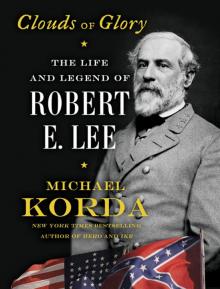- Home
- Michael Korda
Clouds of Glory Page 11
Clouds of Glory Read online
Page 11
This was the boldest and most important decision of Robert E. Lee’s life. Nothing except his children was as important to him as Mary Lee; despite her unpunctuality, her carelessness and untidiness, her total lack of every instinct that might be required to look after a well-ordered household, and her tendency to boss around “Mr. Lee,” as she always called him, whatever military rank he had achieved, he loved her without reservation, and he came not only to respect her strong religious feelings but to share them. She was not at all the compliant wife of Victorian legend: she took a keen interest in politics; her judgment about Lee’s contemporaries and superiors was a good deal sharper and more critical than he was comfortable with, and expressed with a frankness that sometimes mortified him; and, used to getting her own way from childhood on, she did not fall in with his suggestions easily, or conceal her disagreement. He, for his part, was always protective and caring of her, aware that she had given up life on a great estate, surrounded by servants, for a far more modest and confined life as the wife of a junior officer. Neither of them could have foreseen that they would have seven children; or that her health would decline rapidly until she led an invalid life much like his mother’s; or that they would be separated for so much of their marriage by Lee’s duties; or, finally, that his virtues, in which she had always confidently believed, would carry him to a fame beyond anybody’s imagination, and make him the iconic figure of southern rebellion, and of southern manhood, in the North as well as the South.
In marrying Mary, he also acquired a place in Arlington. The house in which he had been born, Stratford Hall, had passed out of the hands of the Lee family in disgraceful circumstances; the great house in which he had spent much of his childhood belonged to his mother’s family, the Carters, not to the Lees. In a society in which the ownership of land and a great mansion counted for much, Robert E. Lee possessed neither; he owned only a few thousand worthless and debt-encumbered acres of wilderness in western Virginia, his uniforms, and his sword, but henceforth, Arlington would play that role in his life, with its impressive portico overlooking Washington, D.C., and its vast collection of the furniture, mementos, and personal belongings of George Washington. It was as if by marriage he had acquired, not wealth—Arlington managed by Mr. Custis could never provide that—but physical roots, a place of his own in landowning Virginia society, and a commanding place at that, for however unprofitable Arlington was, no other house except Mount Vernon itself received more respect.
Perhaps nothing is more symbolic of the change in Robert E. Lee’s life than the fact that Martha Washington’s “Negro maid, Caroline Branham, who had been in the room on the December night when the great spirit of the nation’s founder had passed, was among the servants at Arlington at the time of Mary Custis’s wedding.”
Arlington was to become his home, and with it, as if by adoption, the spirit and the example of George Washington was to guide his life henceforth, and to influence every decision he made.
CHAPTER 3
The Engineer—1831–1846
If family history, a West Point education, an intense and personal admiration for George Washington, and a happy marriage formed a significant part of Robert E. Lee’s character, hydraulics supplied another.
The science of hydraulics was of course part of the curriculum at West Point, and it was the heart and soul of the Corps of Engineers in peacetime, indeed the engineers’ very raison d’être. Their enemy was water: the storms and tides of the sea, the currents and flooding of the great rivers, the navigability of lakes, all these were their responsibility. They deepened and maintained harbors, often where nature had never intended a harbor to be placed; they built canals and locks; they drained marshland; they removed sandbanks and dredged channels to make great rivers navigable for steamboats where not so very long ago the occasional Indian birch bark canoe had been the only vessel; they built levees to prevent rivers from flooding cities and farmland, drew up maps, and constructed massive fortresses to protect the American coastline in places so close to the sea that no sane man would have dared to build a house there. What is more, they did all this with nothing much more than picks, shovels, sledgehammers, and crowbars as tools, a task bigger than the building of the Pyramids, which were at least on solid ground—the creation of a modern infrastructure for a virgin continent. They had been at it since 1779 in war and in peace, and no project was too ambitious or difficult for them; the engineers proceeded at their own slow, steady pace, although underfunded, poorly paid, and grudgingly promoted, challenging nature and transforming the American landscape.
From 1831 to 1846, when the Mexican War began, Robert E. Lee was an engineer, working in places as far apart as Virginia, Saint Louis, Missouri, and New York City, undertaking enormous responsibilities despite his low rank, obliged to account meticulously for every penny he spent, and reporting back to a bureaucracy in Washington that was as firmly bound in red tape and congressional penny-pinching as it was slow-moving. As for almost every officer in the Engineer Corps, water was his chief opponent—he labored to complete a fortress in Virginia (Fort Monroe, known as the “Gibraltar of Chesapeake Bay,” was surrounded by water on three sides and connected to the mainland by only a narrow neck, as well as being further guarded by a wide moat on its perimeter), and another in New York Harbor; he succeeded in diverting the current of the mighty Mississippi River, removing whole islands and rapids and turning the city of Saint Louis into a thriving port, to the gratitude of the city fathers. For all Lee’s study at West Point of Napoleon’s tactics, he was to all intents and purposes a successful civil engineer in uniform—no hint of military genius was required of him, nor did he apparently sense any in himself. Anybody who has ever lived near the sea, a river, or a large body of water knows its latent power. If there was one thing the experience taught Lee it was a determined, patient, almost serene state of mind in facing impossible odds—an attitude that never failed to amaze and impress his subordinates. He had learned it in a hard school—the corps did not accept failure or excuses, however big the task.
The monumental “outworks” of Fort Monroe and the construction of nearby Fort Calhoun (renamed Fort Wool when the Civil War broke out) on an island in Hampton Roads were to occupy Lee for the next three years. It was one thing to have read about the art of fortification in the French classics on the subject at West Point, and another to supervise vast work sites, where the excavation, laying of stone and earth foundations, and final grading were being carried out in preparation for the completion of Vauban’s complex star-shaped, perfectly interlocking seventeenth-century defense works, with their myriad of elaborate and prettily named architectural details: the bastion, the ravelins, the glacis, the counterscarp, all made out of smooth and tightly fitted blocks of stone, just as they were in the reign of Louis XIV, and scientifically designed for the purpose of deflecting artillery shots and permitting a small number of men to hold back attacks by a much larger body of infantry. That the eventual enemy might consist of Americans attacking other Americans, rather than the British approaching by sea, had not as yet occurred to anybody, of course, but even so Lee did his work well: although they were situated in Virginia, Fort Monroe and Fort Wool remained in Union hands throughout the Civil War; indeed Fort Monroe would serve as the prison for Jefferson Davis after the Confederacy was defeated.
Lee’s work was not made easier by the division of authority and the acrimony that reigned at the fort. Fort Monroe was the army’s artillery school and neither its commander nor his gunners liked the presence of the engineers, so there were constant fights between the men, and disputes between Brevet Colonel Eustis, who commanded the fort and the school, and Captain Andrew Talcott, who commanded the engineers and whose large and unruly civilian workforce, white and black, irritated the colonel.
Robert and Mary Lee settled into bare, sparsely furnished quarters in the fort early in August 1831, after a honeymoon of sorts spent visiting their many relatives accompanied by Mrs. Custis. Efforts have be
en made to read into Lee’s correspondence a mild or joshing reference to his sexual relationship with his bride, but this seems far-fetched, since the only comment on which these efforts are based is in a letter to Captain Talcott, written from Ravensworth during his honeymoon: “I would tell you how the time passed, but fear I am too prejudiced to say anything more, but that it went very rapidly & still continues to do so,” and apologizing for not writing sooner. “I actually could not find time before I left the district for anything except——.” As eroticism, this is pretty tame stuff, even by the standards of the time, but there was no doubt in anybody’s mind that Lee was “blissfully happy,” though those who saw the new couple were more impressed by his looks than hers, one of them remarking that he already “looked more like a great man than anyone I have ever seen.”
The contrast between Lee’s appearance—the solemn “great man” even at this early age—and the playfulness and cheeky good humor of his behavior in a private or a social setting was already remarkable. He loved playing with small children and animals (particularly cats), and was deeply sentimental about horses. With pretty young women he was flirtatious—indeed teasing and flirting with them seem to have been a kind of lifelong hobby of Lee’s. During his honeymoon, for example, he wrote to Eliza Mackay, one of the girls in the family he had stayed with in Savannah, to congratulate her on her wedding: “How I should like to say ‘Mr. and Mrs. Lee have the honour to accept Mrs. Mackay’s kind invitation. . . .’ But this cannot be Miss Eliza (My Sweetheart) because it only arrived here last night, by this token that I have been in tears ever since at the thought of losing you. Oh me! . . . But Miss E. how do you feel about this time? Say 12 o’clock of the day, as you see the shadows commence to fall towards the East and know that at last the sun will set? Though you may not be frightened I ’spect you are most marvelously alarmed.”
Resuming the letter a few days later, he wrote: “And how did you disport yourself, My child? Did you go off well, like a torpedo cracker on Christmas morning.” This tone is very typical of Lee’s personal correspondence, a lively and endearing mixture of good-humored taquinerie, as the French call gentle teasing, not in the least improper, but very intimate and full of lighthearted charm: no “Marble Man” here! A Freudian might read a bit more into the reference to the “torpedo cracker,” and suggest that it could refer to Eliza’s wedding night, but that it was all perfectly innocent is attested to by the fact that he showed his letter to Mary, who added a warm, though markedly more formal, note of congratulations of her own. This is a side of Robert E. Lee that has to be kept in mind—he was a pre- or early-Victorian sentimentalist, with a passion for domesticity; a fondness for pretty girls and beautiful women; and a constant deep need for warmth, admiration, and affection from them, perhaps deeper than Mary could supply in the long run. Whatever he may have thought, the tragedy of his life was not so much that he chose a “military education,” but that his service in the army separated him so often from his own beloved family, sometimes for long periods of time.
The Lees’ “apartment” at the fort consisted of only two rooms, in a wing that they shared with Captain Talcott, as well his sister, his brother-in-law Horace Hale, and the Hales’ two children, forming a kind of makeshift household. Of course in the age before indoor plumbing, there was nothing we would recognize as a bathroom, and a very limited amount of privacy, but people were used to this at the time. There was also nothing in the way of a kitchen. Talcott and the Hales had slaves who lived and cooked for them elsewhere in the fort, and brought meals in, and Mary brought along at least one slave of her own, Cassie, probably to serve as her maid. They seem to have enjoyed a busy, if confined, social life. Lee’s friend from West Point, Joseph Johnston, served at the fort, as did several other friends from his cadet days, and Mary seems to have adapted well to life as an army wife for the present, though it must have been a rude change from life at Arlington, where she received constant care from her mother and had a staff of servants to cater to her every whim.
The great French poet and novelist Alfred de Vigny, also a career officer for whom promotion came slowly, wrote Servitude et grandeur militaires at about the same time that the Lees were settling into Fort Monroe, and as Mary would soon learn, army life contained a good deal more servitude than glory. Though the fort was large, and only partly occupied, it was still a stone self-enclosed world, devoted entirely to artillery training or military engineering, and for a woman who loved wildflowers and gardening, and had spent all her life on an estate of 1,100 acres overlooking Washington, it cannot have been an easy transition.
It would not have been improved by the shock of Nat Turner’s slave revolt, which began about fifty miles away in Southampton County, Virginia, on August 22. Nat Turner, a rare slave who had been taught how to read and write, and who had acquired a reputation as something of a charismatic preacher in the small black churches around his master’s plantation, had apparently taken advantage of his Sunday visits to neighboring congregations to plan the revolt. He was not only a student of the Bible, but an inspired prophet, who took a solar eclipse on February 11, 1831, as a sign that he should prepare his revolt and another solar eclipse, perhaps caused by a faraway volcanic eruption, on August 13, as a sign to begin it. (In both cases, the symbolism of a dark cloud blotting out the sun is perhaps significant.) Convinced that “he was ordained for some great purpose in the hands of the Almighty,” Turner had fiery, bloody visions in which he carried out God’s vengeance on slave owners, and in the early hours of the morning of August 22, he and his four closest confederates set out to murder as many nearby slave owners and their families as they could, gathering up more slaves, freed blacks, and weapons as they proceeded, until the total number of Turner’s followers exceeded seventy. In less than two days they killed fifty-six whites, including women, children, infants, and old people, mostly using as weapons the everyday objects that came to hand easily on a farm, axes, picks, spades, and a few old swords—the only person Turner himself killed, a young woman who had befriended him, Margaret Whitehead, he beat to death with a fence post.
That the violence of slavery begat the violence of the revolt is the modern view of the event, and surely the correct one, but of course this did not strike white southerners as the case in 1831. They were not only horrified but indignant and alarmed. Many of Turner’s followers, like Nat Turner himself, had been thought of by their masters as “household servants,” almost members of the family, and not a few of the white victims, particularly the children, were killed by blacks who had known them, cared for them, and looked after them for years. It was as if Old Nat, the faithful coachman of Robert E. Lee’s mother, whom Lee took to Savannah as his servant, and whom he looked after when Nat was ill and dying, had suddenly turned on the Lee family and murdered them.
Turner’s revolt was short-lived, but it was the bloodiest in the two-century history of slavery in America. The local militia put it down quickly and brutally, arresting or killing all of Turner’s followers; in addition, vigilantes and groups of angry or frightened armed citizens killed or lynched an additional 200 or so slaves, probably for no other reason than that they were in the wrong place at the wrong time without an explanation, or looked surly, or didn’t answer questions with enough respect. In some places the severed heads of slaves who had been killed were placed on posts by the side of the road as a warning to others.
Nat Turner spared the local poor white farmers on the grounds that they were not slave owners and had no more respect for themselves than they had for slaves—like John Brown’s raid on Harpers Ferry twenty-eight years later, his was aimed at the institution of slavery; he hoped to shake or destroy it by an act of violence that would serve as an example for others and would rapidly metastasize into a more widespread revolt. It was an outburst of rage against a system of laws and social customs that condemned to bondage 4 million people, and their children and descendants from generation to generation, to be owned, bought, and sold as “chatte
l property” on much the same terms and often with as little sentiment as cattle and horses, and that proposed to go on doing so forever.
Given the size and scope of slavery in the American South it is surprising only that there had not been more or bigger revolts, particularly since the number of slaves in the “near South,” in states like Virginia, was by then in excess of their owners’ need, while at the same time the opening up of vast tracts of new land in the “deep South” was increasing the temptation to sell slaves south for work in the cane fields, rice paddies, and cotton fields of Louisiana and Mississippi, where the climate and working conditions, as well as the notorious brutality of the overseers, made life expectancy of “that peculiar property” short. Old Massah may have been kind enough (in his own mind) to his house slaves, his butler, his cook, his wife’s and daughters’ maids, and willing to overlook a certain slackness in his field hands (Lee’s father-in-law Mr. Custis was a good example of both attitudes), but once he got into debt, or when he died, his creditors or his heirs seldom hesitated to sell his slaves off to be marched farther south in chains to pick cotton under the whip until they dropped—indeed this is the basic theme of Harriet Beecher’s Stowe’s novel Uncle Tom’s Cabin.
By the time of Nat Turner’s revolt a huge forced southbound migration had been in progress for decades, leaving in its wake broken slave “marriages” (which of course had no validity in law) and children separated from their mothers, or sold along with them, whichever was more profitable, and the slave dealer had become a familiar figure in southern cities, even riding from door to door in search of likely “slave property” for sale. If you could pick up several hundred dollars in gold coins for the equivalent of Old Nat, who had been with the Lee family since birth and had given a lifetime of faithful service, how many people would resist the chance when it was offered, with slave prices in New Orleans soaring?

 Passing
Passing Another Life
Another Life Clouds of Glory
Clouds of Glory Hero: The Life and Legend of Lawrence of Arabia
Hero: The Life and Legend of Lawrence of Arabia Cat People
Cat People Hero
Hero With Wings Like Eagles: A History of the Battle of Britain
With Wings Like Eagles: A History of the Battle of Britain Ulysses S. Grant
Ulysses S. Grant